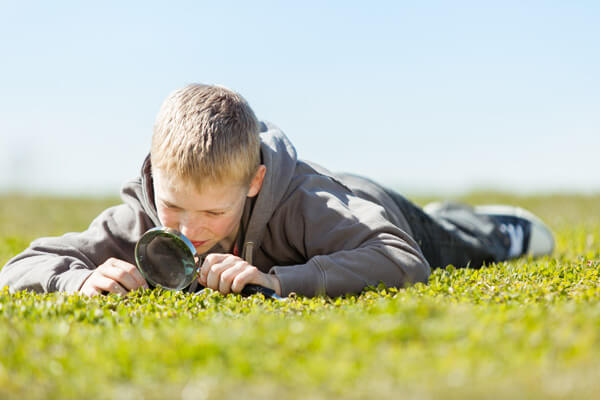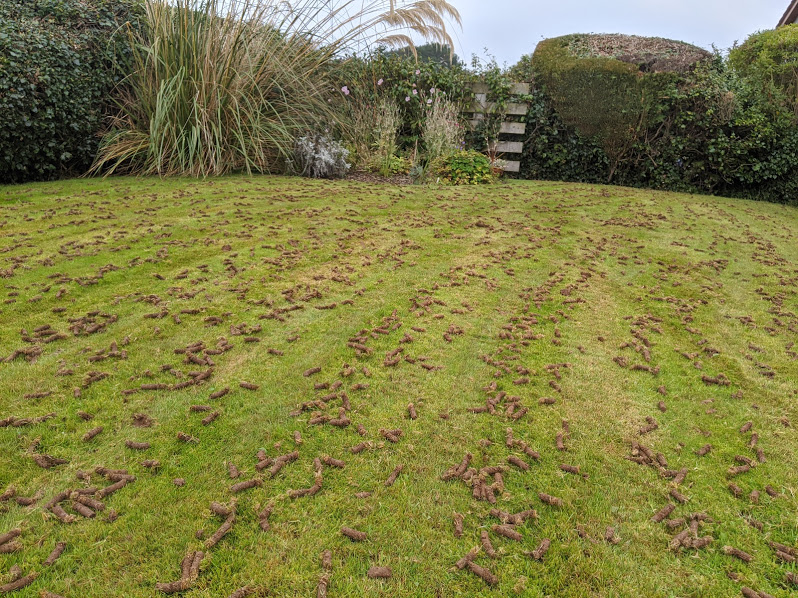In this post, we’re taking an in-depth look at overseeding your lawn and answering some of the most frequently asked questions about overseeding.
Visitors to the Premier Lawns YouTube channel often ask questions about various aspects of lawn care. In today’s blogpost, I’m going to focus on the five most important things you should know about overseeding your lawn.
- What is overseeding and why should it be part of your lawn care regime?
- How to tell if your lawn needs overseeding
- The best time of year to overseed your lawn
- Which type of grass is best for overseeding
- How to get the best results from overseeding
What is lawn overseeding?
Overseeding is a really useful technique for getting a really lovely, velvety texture to your lawn. It’s a quick and easy way to repair the bare patches created by pet urine or by wear and tear. I’ve also found that overseeding – and creating a thick sward on your lawn, helps to prevent weeds getting established.
In the simplest of terms, overseeding just means adding more grass plants to your lawn by sowing seed into any little gaps. That doesn’t mean that you need to be on your knees, looking for spaces and planting seeds. My technique is much easier than that because, in part, it mimics Mother Nature.
Left to her own devices, Mother Nature would naturally overseed your lawn for you. If grass is allowed to grow long and set seed, those seeds will drop back down into the sward and germinate to make another generation of grass plants. However, we interrupt that process by mowing our lawns and preventing seed formation. Overseeding means that we can have a beautifully manicured lawn all year round AND give nature a helping hand. Which is why, overseeding is an important part of my Premier Lawn Care Programme.
How to tell if your lawn needs overseeding

Next time you’re out walking in the countryside, take a close look at the grass verges and the meadows around you. You’ll probably see that although it’s healthy, the grass looks nothing like a lawn.
There are two reasons for this.
Firstly, the species are either wild grasses that have established themselves. Or they are agricultural grasses, bred for their nutrient content rather than their good looks.
Secondly, the grass plants are actually spaced quite far apart. This makes the sward loose and open….quite unlike a lawn.
Lawn care jobs such as aeration, scarification, feeding, overseeding and weed control are all about manipulating the growth habits of individual plants so that they form deeper root systems, sit closer together in the soil and recover quicker from wear and tear.
If your lawn has obvious bare patches – perhaps under trees, by children’s play equipment or where you walk most often. Then it will definitely benefit from overseeding. Other signs that your green carpet is in need of more plants are uneven colour, a thin, pale sward and weak growth.
What is the best time of year to overseed your lawn?
Technically, you can overseed your lawn at any time of year, provided that the soil is warm enough to stimulate germination. But from a practical point of view, I prefer to do this job in spring or autumn. Not only is the soil nice and warm, but the air is moist and there’s plenty of rain to help the seedlings develop.
Ideally, overseeding should follow on from aerating and scarifying – we’ll get on to that later.
Take into account what’s happening in your garden before you plan your overseeding. If your lawn is covered with falling leaves in autumn – overseed in spring so that the seedlings are not disturbed by leaf clearance. If you have a party planned for the summer, seeds sown the previous autumn will be stronger and less likely to be damaged by the extra foot traffic.
Which grass seed should I use for overseeding?
There is no right answer to this question. The grass species you should use depend on lots of different factors.
- How often you use your lawn and what you use it for.
- What soil type you have
- How much sunshine your lawn gets in a day
- Mowing height – how short do you want to mow your lawn?
- Which grass species seem thrive in your lawn
- Whether you are overseeding the whole area or just repairing patches (for patching the grass seed should match your existing lawn otherwise the colour variations will annoy you forever more)
For a family lawn, I would suggest using a ryegrass based seedmix and overseeding the whole lawn.
For a close mown lawn, fescues and bent grasses are traditionally used because they will tolerate being maintained really short. Watch my masterclass on cutting lawns really short.
For a shaded lawn, fescues are great – but see if you can identify the species that are already doing ok in that area before you buy seed. You might be surprised. Not sure how to identify grasses? Subscribe to my YouTube channel – I’m planning a video to help you tell one type of lawn grass from another.
What is the best grass seed for overseeding my lawn?
How to get the best results from overseeding
To get the very best results from overseeding your grass, you need to create the perfect conditions for the seed to germinate. Think of the 4 ’S’s: Space, Soil Contact, Sustenance and Sunlight.
If you simply scatter seeds onto compacted soil, or on to the thatch layer of your lawn, they won’t have much chance of growing into strong plants. Which is why I always scarify and aerate the lawn before overseeding.

Scarifying takes all of the dead and tangled leaves out of the bottom of your lawn to expose the soil between plants and create space. But the real magic happens when you aerate. Hollow tine aeration removes little plugs of soil from the top few centimetres of the ground beneath your lawn. That opens up the soil structure so that roots can grow strong and deep. It also makes tiny natural flower pots in your lawn – the perfect place for seeds to get started.
Mix your grass seed with soil before you scatter it. This guarantees soil contact and helps make sure that the grass seeds (which weigh very little) are pulled down through the sward to the surface of the soil.
The soil mixed with your seeds will fill the flower pots created by the aerator and create ideal growing conditions for young grass plants. If you have any shallow dips the surface of the lawn, the soil/seed mix will help to level them out.
Feed your lawn so that those seeds have a good supply of nutrients as soon as they germinate. And most importantly of all, water. Overseeding in spring or autumn almost guarantees plenty of rain to do the watering for you (especially if you are in Northern Ireland!). However, if the weather is dry, I’d recommend you put the sprinkler on the lawn for a couple of hours to give those seeds a good start.
How much seed do I need?
For overseeding a lawn with a decent sward, I would recommend allowing around 35 grams of grass seed per square metre. If your lawn is bald – increase the quantity to nearer 50 grams per square metre.
A quick note about birds
I’m often asked for tips for keeping birds away from newly overseeded lawns. Honestly – it’s not an easy thing to do. An old farmer friend of mine had a saying about seed rates. He’d say “one to grow and one for the crow” Which is why my seed rates for overseeding tend to be quite generous. Sometimes it’s easier to embrace nature than than to fight her!
For more lawn care advice
Join 30,000 other lawn lovers from around the world and subscribe to my YouTube for up to the minute seasonal lawn care advice. Click here to subscribe
Explore the dozens of articles on my blog.
Learn more about my Premier Lawn Care Programme
Get in touch to ask me a question – you never know, I might even turn your question into a video or a blog.
